Digitalis purpurea - Foxglove
Phylum: Magnoliophyta - Class: Liliopsida - Order: Lamiales - Family: Plantaginaceae
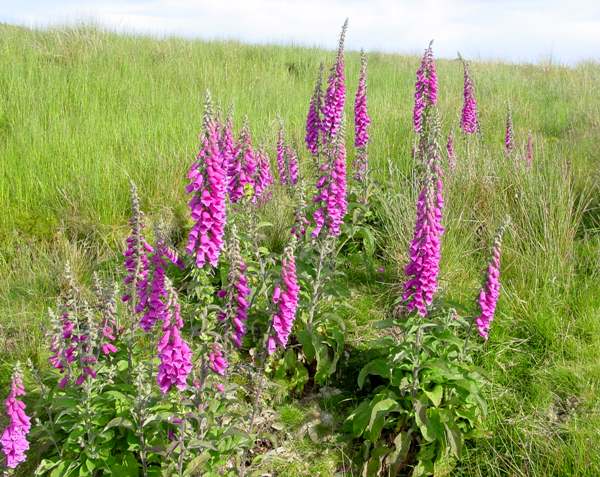
Wherever soil is disturbed, either by forestry clear-felling or earth moving prior to construction work, Foxgloves are usually among the first wildflowers to reappear, invariably in dense swarms.
Description
Foxgloves are biennials, although occasionally plants can live longer than two years. They grow to well over a metre in height and are a splendid sight on the banks ofrivers, lakes and canals as well as on roadsides and woodland edges.
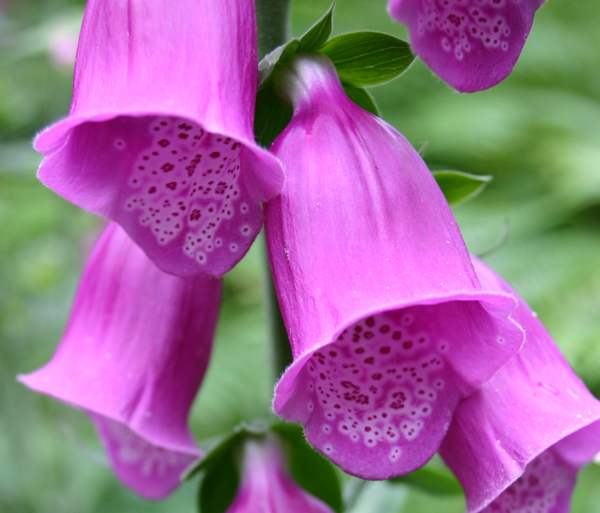
Foxgloves favour acid soils. In the lowlands they do not thrive in heavy, wet clay, but cope much better in sandy, well-drained areas.
In our experience the situation can be rather different in the uplands, where these stately wildflowers often line the eroding banks of small fast-flowing streams and colonise sheltered stony gullies, but they tend to shun waterlogged and marshy areas.
Distribution
These lovely wildflowers are found throughout Britain and Ireland, and they are common throughout most of mainland Europe, even as far south as the Algarve region of Portugal.
This species was introduced to gardens in many other parts of the world including North America, where in many areas it has since escaped into the wild and become naturalised.
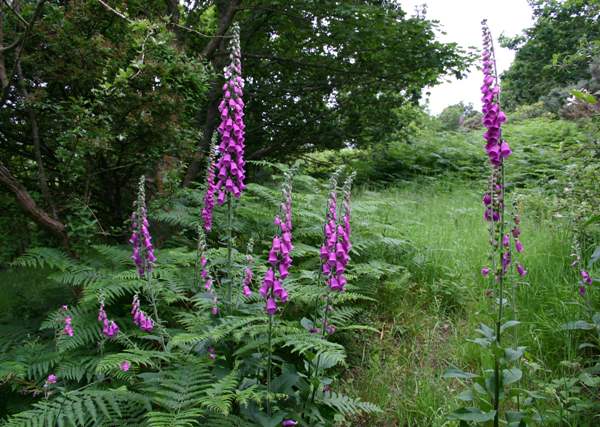
Habitat
In hedgerows facing the sunny south, Foxgloves provide a splendid display throughoutthe summer months.
Blooming Times
We think of Foxgloves not as spring flowers but as the first of the common summer wildflowers. In sheltered lowland spots a few early spikes may appear in early June, with the main display in July and stragglers, particularly those cut down by roadside hedge cutters, pushing up a few inferior spike through to late August.
High in the hills, and particularly in northern Britain, Foxgloves hardly get going until July, and they continue to look good throughout August and into September, by which time the lower flowers have lost their corollas and show their seed cases. Late side shoots may produce a few small flowers.
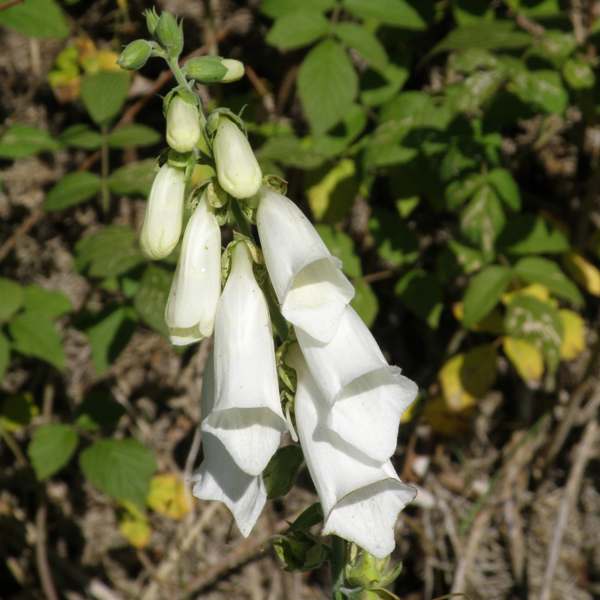
Above: a white Foxglove, northern Scotland
Uses
There are many beautiful cultivars and subspecies of Foxglove. If sowing them as seeds you will need to allow a year for germination and growth, with overwintered plants flowering in the following year.
By removing the dead flowerheads you will encourage a further display of flowers later in the year. (Where we live in West Wales, a few straggly Foxgloves can often be found in bloom as late as November, and they will often pop up and re-flower even after savage cutting back once the main spike has shed its flowers.)
The pharmaceutical compounds digitoxin and digoxin are used to make the drug digitalis, used as a heart stimulant. It was from Foxgloves that these chemicals were first isolated and purified.
In the past herbalists made great use of Digitalis purpurea, whose leaves were also used to make a kind of tea. (We strongly advise against eating or using as medicines any plants without first obtaining qualified professional advice.)
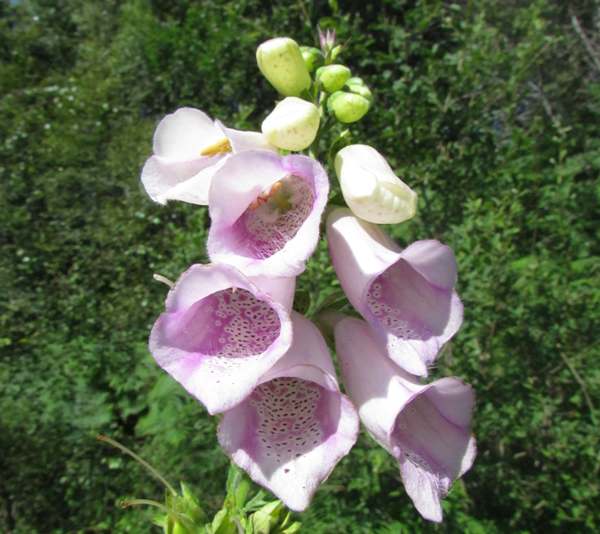
Above: A pink Foxglove among purple- and white-flowered plants, northern Scotland
Etymology
The generic name Digitalis was given to this species and its close relatives by the famous Swedish naturalist Carl Linnaeus in his 1753 publication Species Plantarum; the name Digitalis comes from the Latin noun digitus, which of course means finger.
The individual flowers of the Foxglove are indeed finger shaped, and they also fit very neatly onto the finger like the fingers of a glove or indeed like finger puppets; however, for people with sensitive skin it is important to be aware that just touching foxgloves can be enough to cause itching or even more seriously unpleasant skin irritations.
The specific epithet purpurea refers to the flowers, which are generally purple, although pale pink forms and even white-flowered wild Foxgloves are not uncommon. The white forms are much more common in parts of Scotland, where every patch of purple Foxgloves seems to have its own white companion plant.
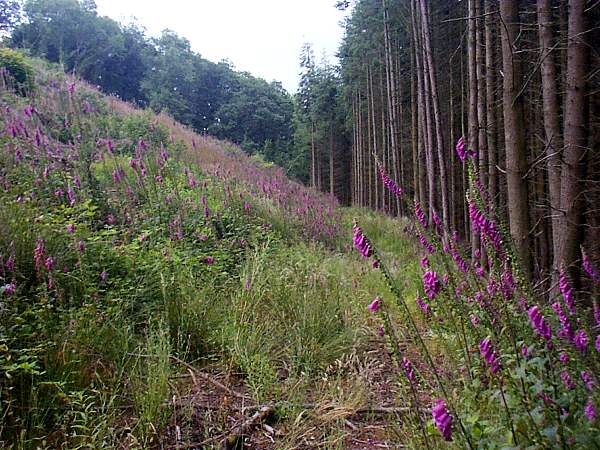
When forest are clear felled the disturbance often results in germination of Foxglove seeds that been lying dormant on or in the leaf litter and/or needle litter. (Wales)
Similar Species
Digitalis lanata is found on mainland Europe but not in Britain; its flowers are cream with brownish veining.
Digitalis lutea, which is grown as a cultivar in Britain and Ireland, is a native wildflower in many parts of central Europe including Slovenia, Austria and Italy.
The pictures of Foxglove plants shown on this page were taken in West Wales and in the far northwest of Scotland between June and the end of August.
Sue Parker's latest ebook is a revised and enlarged edition of Wild Orchids in The Burren. Full details here...
Buy it for just £5.95 on Amazon...
Please Help Us: If you have found this information interesting and useful, please consider helping to keep First Nature online by making a small donation towards the web hosting and internet costs.
Any donations over and above the essential running costs will help support the conservation work of Plantlife, the Rivers Trust and charitable botanic gardens - as do author royalties and publisher proceeds from books by Pat and Sue.

